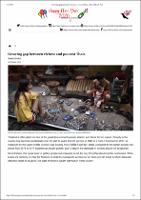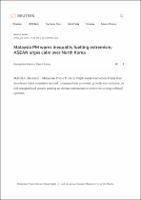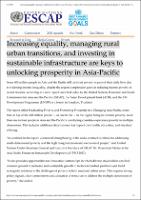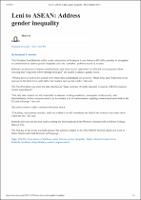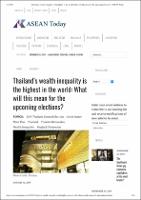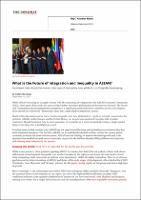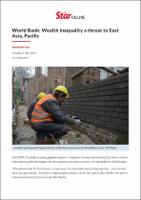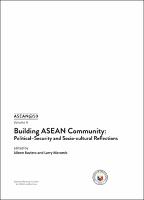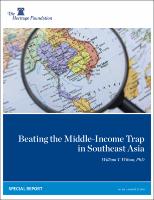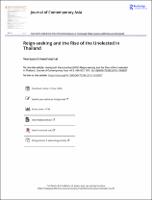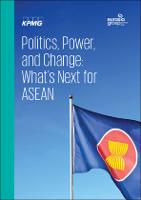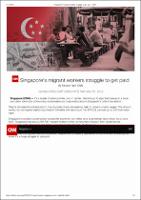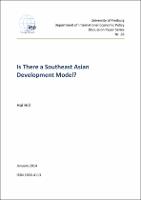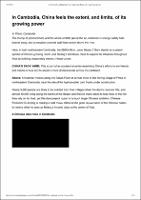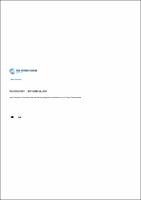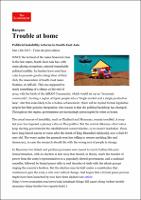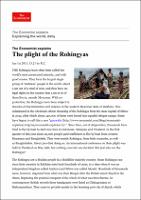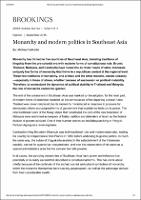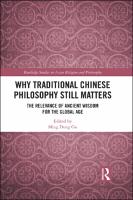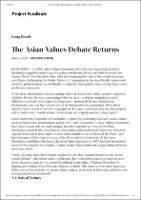Browsing by Submit Date
Now showing items 41-60 of 299
-
Growing gap between richest and poorest Thais
(the ASEAN Post, 2019-10-25) -
Malaysia PM warns inequality fuelling extremism; ASEAN urges calm over North Korea
(Reuter, 2017-04-28) -
Leni to ASEAN: Address gender inequality
(Manila Bulletin News, 2017-11-07) -
Thailand’s wealth inequality is the highest in the world: What will this mean for the upcoming elections?
(United Nation ESCAP, 2019-01-16) -
What is the Future of Integration and Inequality in ASEAN?
(the Diplomat, 2017-09-15) -
World Bank: Wealth inequality a threat to East Asia, Pacific
(the Star Online, 2017-12-04) -
ASEAN @50Volume 4: Building ASEAN Community: Political-Security and Socio-cultural Reflections
(ERIA, 2017)
ASEAN has gradually built, on the basis of both shared interests and common principles and norms, various practices and mechanisms that helped prevent conflict among its members and allowed it to play an autonomous role in shaping the regional security architecture. Overcoming the member states' preoccupation with their own national concerns to give way to advocacy of collective interests has remained difficult, but progress is being made. Part A of this volume looks at the processes and dynamics, challenges, and opportunities of ASEAN ... -
Beating the Middle-Income Trap in Southeast Asia
(The Heritage Foundation, 2014)
Since 2000, Southeast Asia has had some of the fastest growing economies in the world. Indonesia’s economy has enjoyed 6 percent annual growth—but will its lack of infrastructure and its commodity dependence soon reveal some cracks in its economy? The remarkable growth in the Philippines will not last unless domestic investment is elevated. Thailand’s growth has stalled amid political turmoil, and it is currently in a classic credit bubble. Vietnam still generates impressive growth, but it has a banking problem, high inflation, and ubiquitous ... -
Reign-seeking and the Rise of the Unelected in Thailand
(Journal of Contemporary Asia, 2016)
This article develops the concept of “reign-seeking” to capture the unprecedented collective action of the Thai professional and official elite prior to the 2014 military coup and the establishment of a military regime. It argues that this phenomenon reflects broad and deep political dynamics, for which the dominant scholarship on authoritarianism and Thai politics cannot adequately explain. The changing incentives of these supposedly non-partisan actors are interwoven with neo-liberal governance reform driven by a desire for depoliticisation and ... -
Politics, Power, and Change
(KPMG)
There are 10 varied and challenging national storylines unfolding in ASEAN – and businesses need to join these conversations. Juggling the many demands of an increasingly complex stakeholder universe – from consumers to politicians, regulators to society at large – will require an understanding of the wide array of domestic and regional political risks in ASEAN. While there are some challenges that are common to many countries in ASEAN, the level of risk and trend direction vary. There are several questions on geo-strategy in the region: Will ... -
Singapore's migrant workers struggle to get paid
(CNN, 2018) -
Is There a Southeast Asian Development Model?
(Department of International Economic Policy Institute for Economic Research University of Freiburg, 2014)
The 10 states of Southeast Asia have combined to form the developing world’s most successful and durable regional grouping, the Association of Southeast Asian Na-tions, ASEAN. Economic integration among them is high and increasing. The ambi-tious ASEAN Economic Community is scheduled to take effect from December 2015, and should further accelerate this integration. But the socio-economic and institution-al disparities among them are also very large. This paper therefore asks the ques-tion, does it make sense to contemplate a ‘Southeast Asian ... -
In Cambodia, China feels the extent, and limits, of its growing power
(Washington post, 2015) -
How Countries in Southeast Asia are Working Together to Accelerate Human Capital Development
(THE WORLD BANK, 2019) -
Trouble at home: Political Instability Southeast Asia
(The Economist, 2015) -
The Economist explains_ The plight of the Rohingyas
(The Economist, 2015) -
Monarchy and modern politics in Southeast Asia
(Brooking Institution, 2015) -
Why traditional Chinese philosophy still matters: the relevance of ancient wisdom for the global age
(Routledge/ Taylor & Francis Group, 2018) -
The Asian Values Debate Returns
(Project Syndicate, 2018)

